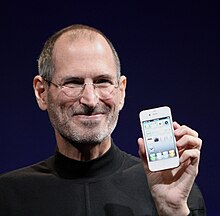
Steven Paul "Steve" Jobs (/ˈdʒɒbz/; February 24, 1955 – October 5, 2011) was an American entrepreneur, marketer, and inventor, who was the co-founder, chairman, and CEO of Apple Inc. Through Apple, he is widely recognized as a charismatic and design-driven pioneer of the personal computer revolution and for his influential career in the computer and consumer electronics fields, transforming "one industry after another, from computers and smartphones to music and movies." Jobs also co-founded and served as chief executive of Pixar Animation Studios; he became a member of the board of directors of The Walt Disney Company in 2006, when Disney acquired Pixar. Jobs was among the first to see the commercial potential of Xerox PARC's mouse-driven graphical user interface, which led to the creation of the Apple Lisa and, a year later, the Macintosh. He also played a role in introducing the LaserWriter, one of the first widely available laser printers, to the market.
After a power struggle with the board of directors in 1985, Jobs left Apple and founded NeXT, a computer platform development company specializing in the higher-education and business markets. In 1986, he acquired the computer graphics division of Lucasfilm, which was spun off as Pixar.[12] He was credited in Toy Story (1995) as an executive producer. He served as CEO and majority shareholder until Disney's purchase of Pixar in 2006.[13] In 1996, after Apple had failed to deliver its operating system, Copland, Gil Amelio turned to NeXT Computer, and the NeXTSTEP platform became the foundation for the Mac OS X.[14] Jobs returned to Apple as an advisor, and took control of the company as an interim CEO. Jobs brought Apple from near bankruptcy to profitability by 1998.
As the new CEO of the company, Jobs oversaw the development of the iMac, iTunes, iPod, iPhone, and iPad, and on the services side, the company's Apple Retail Stores, iTunes Store and the App Store.[18] The success of these products and services provided several years of stable financial returns, and propelled Apple to become the world's most valuable publicly traded company in 2011.[19] The reinvigoration of the company is regarded by many commentators as one of the greatest turnarounds in business history.
In 2003, Jobs was diagnosed with a pancreas neuroendocrine tumor. Though it was initially treated, he reported a hormone imbalance, underwent a liver transplant in 2009, and appeared progressively thinner as his health declined. On medical leave for most of 2011, Jobs resigned in August that year, and was elected Chairman of the Board. He died of respiratory arrest related to the tumor on October 5, 2011.
Jobs received a number of honors and public recognition for his influence in the technology and music industries. He has been referred to as "legendary", a "futurist" and a "visionary", and has been described as the "Father of the Digital Revolution," a "master of innovation "the master evangelist of the digital age" and a "design perfectionist."
Early life
Jobs's birth parents met at the University of Wisconsin at Madison, where his Syrian-born biological father, Abdulfattah "John" Jandali (Arabic: عبدالفتاح جندلی), was an undergraduate and then graduate student, and where his biological mother, Swiss-American Joanne Carole Schieble, studied for a degree in speech language pathology. Jandali, who emigrated to the U.S. from Homs, Syria at the age of 19, was a graduate student studying political science when he met and became involved with Ms. Schieble. When Ms. Schieble became pregnant, her fundamentalist father vehemently refused to let her marry Jandali, and Ms. Schieble ended up going to California to have the baby and give it up for adoption. About six months later, Ms. Schieble's father died suddenly, and she was then able to marry Jandali. Jandali swiftly finished his Ph.D. and got a teaching position at the University of Wisconsin, Green Bay. The couple moved there and then had another child, Mona, who is Steve Jobs' full sister. Their marriage lasted only about five years, and then Ms. Schieble moved with her daughter to Los Angeles, and later remarried
Jobs was born in San Francisco, California on February 24, 1955. He was adopted at birth by Paul Reinhold Jobs (1922–1993) and Clara Jobs (née Hagopian) (1924–1986), an Armenian American. Paul and Clara had gotten married in March 1946, ten days after they met. Clara had an ectopic pregnancy and couldn't bear children. In 1955, nine years after their marriage, they decided to adopt a child.[44] According to Steve Jobs's commencement address at Stanford, Schieble wanted Jobs to be adopted only by a college graduate couple. Schieble learned that Clara Jobs had not graduated from college and Paul Jobs had only attended high school, but signed final adoption papers after they promised her that the child would definitely be encouraged and supported to attend college. Later, when asked about his "adoptive parents", Jobs replied emphatically that Paul and Clara Jobs "were my parents He stated in his authorized biography that they "were my parents 1,000%." Walter Isaacson wrote in his authorized biography about Steve Jobs that Steve had told him, "Paul and Clara are 100% my parents. And Joanna and Abdulfatah—are only a sperm and an egg bank. It's not rude, it is the truth." Unknown to him, his biological parents would subsequently marry (December 1955), have a second child, novelist Mona Simpson, in 1957, and divorce in 1962.
The Jobs family moved from San Francisco to Mountain View, California when Jobs was five years old.[40][41] The parents later adopted a daughter, Patty.] Paul worked as a mechanic and a carpenter, and taught his son rudimentary electronics and how to work with his hands.[40] Paul showed Steve how to work on electronics in the family garage, demonstrating to his son how to take apart and rebuild electronics such as radios and televisions. As a result, he became interested in and developed a hobby of technical tinkering.]
Clara was an accountantwho taught him to read before he went to school.[40] Clara Jobs had been a payroll clerk for Varian Associates, one of the first high-tech firms in what became known as Silicon Valley.[48]
Jobs's youth was riddled with frustrations over formal schooling. At Monta Loma Elementary school in Mountain View, he frequently played pranks on others.] Though school officials recommended that he skip two grades on account of his test scores, his parents elected for him only to skip one grade.
Jobs then attended Cupertino Junior High and Homestead High School in Cupertino, California. At Homestead, Jobs became friends with Bill Fernandez, a neighbor who shared the same interests in electronics. Fernandez introduced Jobs to his neighbor, Steve Wozniak, a computer and electronics whiz kid, who was also known as "Woz". In 1969 Wozniak started building a little computer board with Fernandez that they named "The Cream Soda Computer", which they showed to Jobs; he seemed really interested. Wozniak has stated that they called it the Cream Soda Computer because he and Fernandez drank cream soda all the time whilst they worked on it and that he and Jobs had gone to the same high school, although they did not know each other there.
Following high school graduation in 1972, Jobs enrolled at Reed College in Portland, Oregon. Reed was an expensive college which Paul and Clara could ill afford. They were spending much of their life savings on their son's higher education. Jobs dropped out of college after six months and spent the next 18 months dropping in on creative classes, including a course on calligraphy.[52] In the commencement address he gave at Stanford, Jobs said that, while he continued to audit classes at Reed, he slept on the floor in friends' dorm rooms, returned Coke bottles for food money, and got weekly free meals at the local Hare Krishna temple. In that same speech, Jobs said: "If I had never dropped in on that single calligraphy course in college, the Mac would have never had multiple typefaces or proportionally spaced fonts
